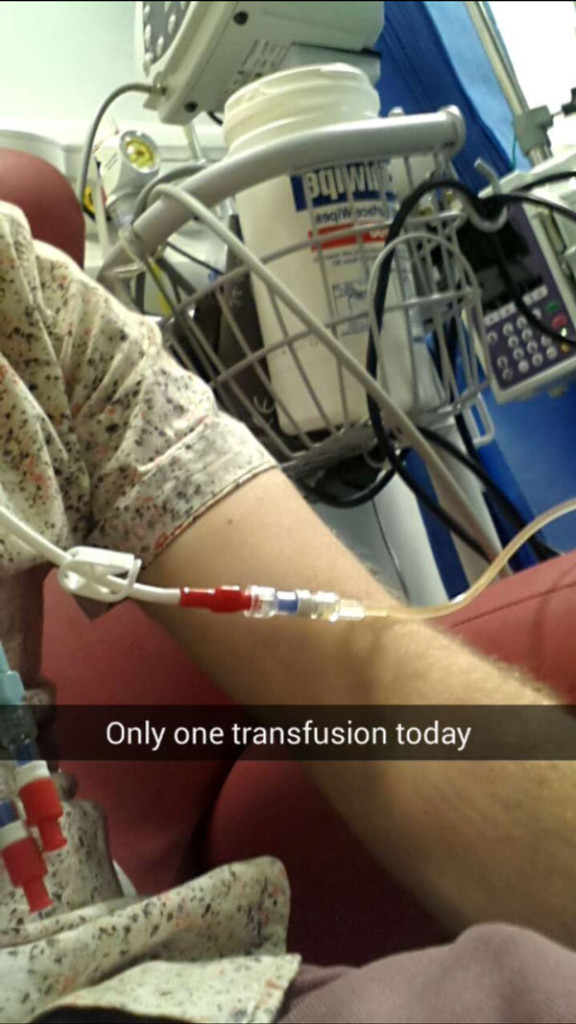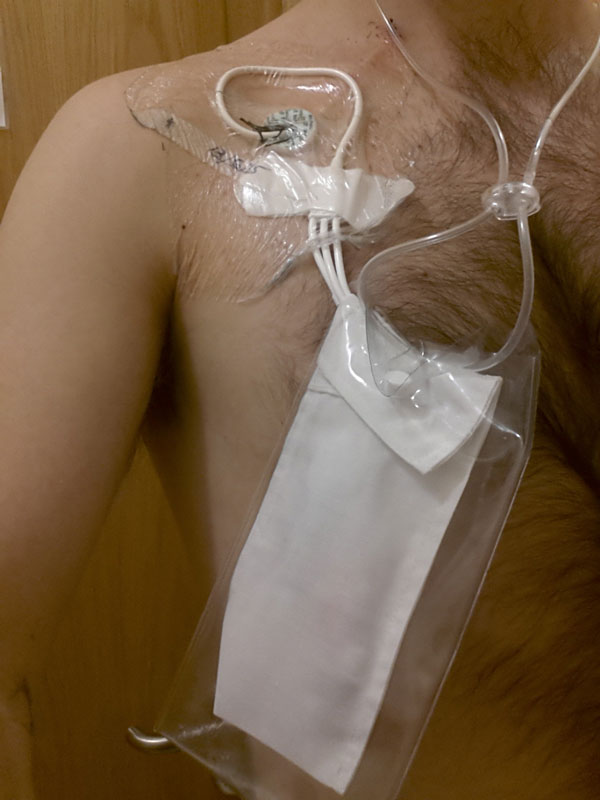The Hickman line, also known as a central line, is something that most transplant patients experience in the course of their treatment. In our second blog post from Adam Riley, he talks about having his Hickman Line inserted and what it's like to live with one. Read Adam's first blog post here. (Warning - you might find some of Adam's images a bit graphic if you're feeling squeamish!)
On 9 June, I had my Hickman Line inserted.
I’d known for a while that I’d be getting one, but I didn’t really know what it was. A fellow patient at King’s Haematology Ward had shown me her Hickman Line and said that she’d had no issue with it, but nothing had really been said about the whole procedure.
I thought it would be similar to having cannulas (small tubes) in my arms, but instead inserted into my chest. This wasn’t the case. I didn’t realise I would have to have an operation in order for the Hickman Line to be inserted.
Prior to having the surgery, I had two bags of platelets, as my platelet levels had to be over 50. At the time they were just 9 – which isn’t the lowest I’ve had by a long way.
When the time came to have the surgery I was taken to a ward and had to strip off and put a hospital gown on. The gowns are a lot more complicated to get on than I’d previously thought, and I was wearing it back to front before a nurse finally told me. Thankfully, however, I was allowed to keep my boxers on underneath.
As is usual with any kind of procedure at hospital, I had someone come and talk to me before the operation to inform me of all the risks. Before that conversation, I was feeling pretty chilled out and relaxed about everything, sending annoying Snapchats of me in my funky gown to my mates. After the conversation, I was somewhat less relaxed.
While waiting I listened to my iPod to get myself psyched up; notably what has become my adopted hospital song, Frank Sinatra’s That’s Life.
The operation to insert a Hickman Line
The operating theatre was a proper operating theatre, like from the TV show Scrubs and various films. The surgeons and nurses were all extremely nice and friendly. In order to have the surgery, I had to have part of the right side of my chest shaved, which was probably the longest part of the whole procedure. This was done to reduce the risk of infection.
I was then hooked into a machine which would monitor my vital signs throughout, such as my pulse, heart rate, temperature, etc. I was covered in blue sheets, with just the part of me that would be being operated on left uncovered.
The side of my head was also covered so that I couldn’t see what was going on. I could only gaze blankly out of my left eye at the wall. The surgeons had to wait a minute, as my heart rate was really high before they started. Not that I was scared. Nothing scares me.
They began by making markings on my skin where the incisions would be made. I was told that I would feel stinging as the surgeon applied lots of local anaesthetic. It’s strange, as you can feel the surgeons making incisions and inserting the wires, but because I’d been made numb there was obviously – and thankfully – no pain.
I could feel my blood running across my chest as they operated on me, which is probably the strangest sensation of the whole ordeal, but ultimately the procedure was really easy.

As the wire was going quite far along my vein, the bed I was laying on was being continuously rotated to allow the surgeons better angles to manoeuvre the wire within me. I then needed to have some stitches to make sure that the Hickman Line wouldn’t fall out, as apparently that does sometimes happen.
What it's like to have a Hickman line
It took a few days to get used to my Hickman Line, and it was quite sore for a little while, but in a really weird way I do quite like it.

It certainly helps in relation to my treatment, as it means that I no longer have my arms pricked with cannulas. (Which is great, as they were beginning to look bruised and nasty.) Instead, the nurses now just connect vials and transfusions to the connectors that hang off the Hickman Line. It’s so much easier and quicker.
It can be difficult to keep the dressing dry during showers, but that’s the only issue I’ve had with it. To help keep it dry while showering I bought a Hickman Line cover, which has been really helpful. However, it doesn’t cover the dressing on my chest, which can come loose if I’m not careful.
I thought I would struggle with sleeping, as I like to sleep literally face down into my pillow like a weirdo, but that’s been fine too.
The dressing is supposed to be changed no more than once a week in order to reduce the risk of infection. I have found recently that the heat of the summer is forcing the dressing to come loose, meaning that I need to have it changed almost every other day – which is obviously not good. I never thought I’d complain about Britain being too hot.
Get more information and advice for patients on our website at www.anthonynolan.org/patientinfo, or visit our Transplant Community forum at www.anthonynolan.org/transplantcommunity
Visit Adam's blog about his treatment for Aplastic Anaemia at http://adaminhospital.blogspot.co.uk/


